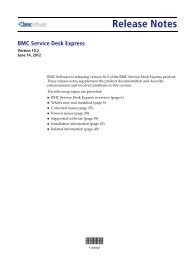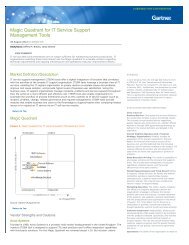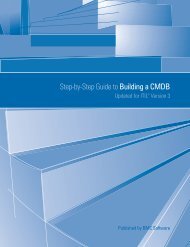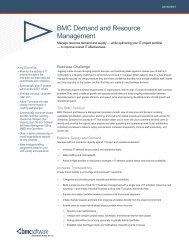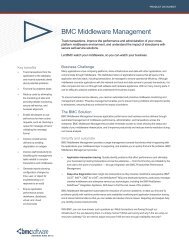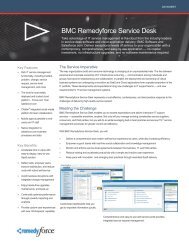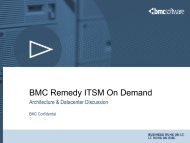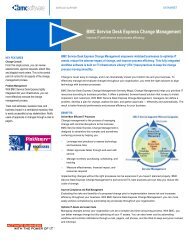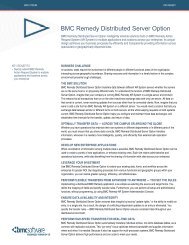Understanding itiL® service portfolio Management and the service ...
Understanding itiL® service portfolio Management and the service ...
Understanding itiL® service portfolio Management and the service ...
Create successful ePaper yourself
Turn your PDF publications into a flip-book with our unique Google optimized e-Paper software.
est practices WHITE PAPER<strong>Underst<strong>and</strong>ing</strong> ITIL ® Service Portfolio <strong>Management</strong><strong>and</strong> <strong>the</strong> Service CatalogAn approach for implementing effective <strong>service</strong> lifecycle management
Table of ContentsExecutive Summary.....................................................................................................................1Service Portfolio <strong>Management</strong> According to ITIL....................................................................2> > Service Lifecycle <strong>Management</strong>...................................................................................................2> > Business Service <strong>Management</strong>..................................................................................................2The Service Portfolio as a Strategic Asset................................................................................3Service Portfolio Details..............................................................................................................3> > Service Pipeline...........................................................................................................................3> > Service Catalog...........................................................................................................................4> > Retired Services..........................................................................................................................4A Closer Look at <strong>the</strong> Service Catalog.........................................................................................4> > Structure......................................................................................................................................4> > The Role of <strong>the</strong> Configuration <strong>Management</strong> System <strong>and</strong> Configuration <strong>Management</strong> Database .... 5> > Enabling Service-Oriented Architecture Applications .................................................................5Implementing <strong>and</strong> Leveraging <strong>the</strong> Service Portfolio...............................................................6> > Gaining Control of Development Projects...................................................................................6> > Automating Service Request <strong>Management</strong>................................................................................6> > Extending Beyond IT Services....................................................................................................6Conclusion.....................................................................................................................................7
Executive SummaryImagine trying to run a manufacturing business without a comprehensive, detailed view of <strong>the</strong> productsprovided by your company. It would be difficult to know all <strong>the</strong> products currently planned, in development,or available to customers. You wouldn’t know <strong>the</strong> recurring or nonrecurring product costs, <strong>the</strong>prices, or <strong>the</strong> sources of products <strong>and</strong> component assemblies. How could you even determine <strong>the</strong>support resources required for each product or <strong>the</strong> product’s warranty options?Manufacturing firms learned long ago about <strong>the</strong> importance of maintaining comprehensive <strong>and</strong>accurate documentation on <strong>the</strong>ir product lines. Such information provides <strong>the</strong> foundation for informeddecision making.IT executives <strong>and</strong> <strong>the</strong>ir teams face a similar need to have a comprehensive <strong>and</strong> accurate view of IT<strong>service</strong>s. Without this view, it’s difficult, if not impossible, to run IT as a business. To be successful,take a lesson from manufacturing firms <strong>and</strong> create comprehensive <strong>and</strong> accurate documentation ofyour “products,” including planned <strong>and</strong> existing <strong>service</strong>s. The result is a <strong>service</strong> catalog that includesall relevant details about each <strong>service</strong>, including which <strong>service</strong> level agreements (SLAs) are associatedwith it, who is able to request it, how much it costs, <strong>and</strong> how to fulfill it.You can leverage this information to gain full control of your <strong>service</strong> <strong>portfolio</strong> through effective <strong>service</strong><strong>portfolio</strong> management. This approach helps you focus on your priorities to improve <strong>the</strong> <strong>service</strong>s thatsupport <strong>the</strong> business. It allows for <strong>the</strong> most efficient use of IT resources, which reduces costs <strong>and</strong>helps increase business agility <strong>and</strong> user satisfaction. Ultimately, <strong>service</strong> <strong>portfolio</strong> management sets upa process for <strong>the</strong> business to generate greater value.This paper describes <strong>the</strong> IT Infrastructure Library ® (ITIL ® ) Version 3 (V3) approach to <strong>service</strong> <strong>portfolio</strong>management. It examines <strong>the</strong> various components of <strong>the</strong> <strong>service</strong> <strong>portfolio</strong>, such as <strong>the</strong> <strong>service</strong> catalog.In addition, it discusses technologies available to develop <strong>and</strong> manage <strong>the</strong> <strong>service</strong> <strong>portfolio</strong> <strong>and</strong> toleverage <strong>the</strong> information contained in <strong>the</strong> catalog.PAGE > 1
Service Portfolio <strong>Management</strong> Accordingto ITILITIL stresses <strong>the</strong> importance of effectively managing <strong>the</strong>entire lifecycle of every <strong>service</strong> — from request to retirement.This requires a disciplined approach to <strong>the</strong> following:>>Performing a strategic assessment of <strong>the</strong> benefits <strong>and</strong>potential value generation of <strong>the</strong> IT <strong>service</strong>s>>Evaluating requests for new <strong>service</strong>s or for enhancementsto current <strong>service</strong>s>>Planning <strong>and</strong> developing new <strong>and</strong> enhanced <strong>service</strong>s forrequests that have been approved>>Deploying new <strong>and</strong> enhanced <strong>service</strong>s into operation withminimal risk>>Effectively managing <strong>and</strong> supporting operational <strong>service</strong>s>>Continually evaluating <strong>service</strong>s <strong>and</strong> searching for areasof improvement>>Retiring <strong>service</strong>s that no longer have business valueMany IT organizations are already addressing <strong>the</strong> managementof deployed <strong>service</strong>s by using available <strong>service</strong>management tools <strong>and</strong> solutions. These tools enable IT tomaintain <strong>service</strong> delivery at agreed-upon levels <strong>and</strong> provideeffective support. Solutions are also available that enableIT to underst<strong>and</strong> <strong>the</strong> relationships of <strong>the</strong> <strong>service</strong>s to <strong>the</strong>underlying technology components that support <strong>the</strong>m,as well as <strong>the</strong> business priorities of <strong>the</strong> <strong>service</strong>s.Service Lifecycle <strong>Management</strong>IT organizations are looking at ways to gain better controlof <strong>service</strong>s by addressing <strong>the</strong> management of <strong>the</strong> full<strong>service</strong> lifecycle.ITIL V3 provides an approach for implementing effective <strong>service</strong>lifecycle management — Service Portfolio <strong>Management</strong>.As defined in Section 5.4 of <strong>the</strong> ITIL V3 Service Strategybook 1<strong>and</strong> illustrated in Figure 1, <strong>service</strong> <strong>portfolio</strong> managementconsists of four major steps:> >Define. Collect information <strong>and</strong> inventories of existing<strong>service</strong>s. Establish <strong>the</strong> requirements for <strong>the</strong> requested<strong>service</strong>, <strong>and</strong> establish <strong>the</strong> business case for implementing<strong>the</strong> <strong>service</strong>.> >Analyze. Review <strong>the</strong> long-term business goals, <strong>and</strong> determinewhat <strong>service</strong>s are required to meet those goals.Then analyze <strong>the</strong> requested <strong>service</strong> for financial viability,operational capability, <strong>and</strong> technical feasibility to determinehow <strong>the</strong> organization is going to get <strong>the</strong>re. (You may decideto obtain <strong>the</strong> <strong>service</strong> from an outsourcer ra<strong>the</strong>r than developit internally.)> >Approve. Make a decision to retain, replace, renew,or retire <strong>the</strong> <strong>service</strong>s.> >Charter. Communicate action items to <strong>the</strong> organizationto implement approved <strong>service</strong>, <strong>and</strong> allocate budget<strong>and</strong> resources.Figure 1. Service Portfolio <strong>Management</strong>The define, analyze, <strong>and</strong> approve steps are described in <strong>the</strong>ITIL V3 Service Strategy book. The charter step is discussedin <strong>the</strong> ITIL V3 Service Design book.Business Service <strong>Management</strong>The <strong>service</strong> <strong>portfolio</strong> management process requires continualre-evaluation <strong>and</strong> refreshing of <strong>service</strong>s to adapt to changingbusiness conditions. This can be accomplished through morerigorous planning <strong>and</strong> analysis based on comprehensivebusiness information, such as leveraging top-down BusinessService <strong>Management</strong> (BSM) analysis. BSM is an approachfor managing IT from <strong>the</strong> perspective of <strong>the</strong> business. Byfollowing this approach, you can make better decisions aboutwhich <strong>service</strong>s to develop, deploy, <strong>and</strong> retain. The processhelps you make more effective decisions based on businessfactors — such as cost <strong>and</strong> expected value to <strong>the</strong> business —as well as on technical feasibility. With a view of your <strong>service</strong><strong>portfolio</strong>, you can readily identify o<strong>the</strong>r <strong>service</strong>s that provide<strong>the</strong> same or similar functions as a requested <strong>service</strong> to avoidduplicating <strong>service</strong>s.Effective <strong>service</strong> <strong>portfolio</strong> management helps you makebetter-informed, make-or-buy decisions, such as whe<strong>the</strong>r tooutsource. You can determine <strong>the</strong> actions to take related topricing <strong>service</strong>s because you’ll have accurate cost information.This approach also helps you determine which <strong>service</strong>s torun as usual <strong>and</strong> which to transform into new <strong>service</strong>s asdetermined by business needs <strong>and</strong> your ability to exp<strong>and</strong>your offerings. Finally, it lets you retire a <strong>service</strong> that doesnot meet minimum technical <strong>and</strong> functional objectives. Asa result, you’ll improve your <strong>service</strong> offering by focusing on<strong>service</strong>s that deliver <strong>the</strong> most value to <strong>the</strong> business.PAGE > 2
In a mature IT organization, <strong>the</strong> most complex task of an ITexecutive is to integrate IT goals <strong>and</strong> objectives with overallbusiness goals <strong>and</strong> value drivers. To organize <strong>the</strong> activitiesof IT around <strong>the</strong> business, IT needs to find a mechanism tolink IT processes to business processes. This is a difficulttask since IT <strong>and</strong> <strong>the</strong> business typically speak a differentlanguage <strong>and</strong> have goals <strong>and</strong> objectives that are not alwaysdirectly connected. The best way to focus communicationis for IT to answer <strong>the</strong> question, “What is <strong>the</strong> desired outcomefor <strong>the</strong> business?”The IT organization needs to manage IT as a <strong>service</strong>, ra<strong>the</strong>rthan as individual technology components. Managing <strong>service</strong>sis a lot more complex, <strong>and</strong> it requires that many individualtechnology components work toge<strong>the</strong>r to deliver <strong>the</strong> desiredbusiness outcome.A BSM approach focuses on linking <strong>service</strong> assets tohigher-level business <strong>service</strong>s. This approach enables ITto make business sense of individual technology components.These metrics <strong>and</strong> <strong>the</strong> ultimate business goalsneed to be documented <strong>and</strong> carried forward as part of<strong>service</strong> <strong>portfolio</strong> management.The Service Portfolio as a Strategic AssetEach one of <strong>the</strong>se attributes should also be part of <strong>the</strong>governance requirements. Therefore, keeping track of <strong>the</strong>mas part of <strong>service</strong> <strong>portfolio</strong> management allows strict controlover <strong>the</strong> projects <strong>and</strong> enables corporate audit processesrequired for risk assessment <strong>and</strong> audit compliance checks.The <strong>service</strong> <strong>portfolio</strong> maintains three categories of <strong>service</strong>s,defined by lifecycle phase:> >Service Pipeline. Services that are planned or in developmentbut not yet available to <strong>service</strong> consumers> >Service Catalog. Services that are currently released<strong>and</strong> deployed or ready for deployment> >Retired Services. Services that are no longer activeFigure 2 shows how <strong>service</strong>s move through <strong>the</strong> categoriesof <strong>the</strong> <strong>service</strong> <strong>portfolio</strong> during <strong>the</strong>ir lifecycle.Service Knowledge <strong>Management</strong>System (SKMS)Service PortfolioService LifecycleThe <strong>service</strong> <strong>portfolio</strong> defined by ITIL V3 provides <strong>the</strong> datafoundation for <strong>service</strong> <strong>portfolio</strong> management. The mostimportant step in <strong>portfolio</strong> management involves strategicanalysis. Look at <strong>the</strong> market space <strong>and</strong> your customersto analyze which areas will provide <strong>the</strong> most value to yourbusiness. The analysis involves considering your owncapabilities <strong>and</strong> resources, as well as those of suppliers,to help you determine whe<strong>the</strong>r to run <strong>the</strong> business as usualor to grow it. In some cases, a unique opportunity presentsitself in <strong>the</strong> market, <strong>and</strong> you must transform <strong>the</strong> <strong>service</strong> tocreate a new opportunity for <strong>the</strong> business.SERVICE STATUSRequirementsDefinedAnalyzedApprovedCharteredDesignedDevelopedBuiltTestedReleasedOperationalRetiredSERVICEPIPELINESERVICECATALOGRETIREDSERVICESService Strategy FocusService Design /Service Transition FocusAll IT organizations depend on vendors for applications,<strong>service</strong>s, <strong>and</strong> operational capabilities. Those vendors thatprovide a strategic <strong>service</strong> should be included in <strong>the</strong> strategicanalysis. Service <strong>portfolio</strong> management has a criticaldependency on <strong>the</strong> supplier management process to ensurecontrol over cost <strong>and</strong> resources. The ultimate goal is tomaximize value <strong>and</strong> keep control of your vendor <strong>portfolio</strong>.Service Portfolio DetailsFor each <strong>service</strong>, ITIL defines <strong>the</strong> attributes that shouldbe maintained in <strong>the</strong> <strong>service</strong> <strong>portfolio</strong>, such as <strong>service</strong>description, business case, value proposition, priority, risks,offerings, packaging, costs, <strong>and</strong> pricing. These are evaluatedthroughout <strong>the</strong> lifecycle of <strong>the</strong> <strong>service</strong> project, from strategicanalysis of a new <strong>service</strong> until <strong>the</strong> <strong>service</strong> is retired.Figure 2. Service Lifecycle CategoriesService PipelineThe <strong>service</strong> pipeline represents <strong>the</strong> strategic outlook thatyou, <strong>the</strong> <strong>service</strong> provider, should take. Services begin <strong>the</strong>irlifecycle in <strong>the</strong> <strong>service</strong> pipeline, starting with <strong>the</strong> strategicassessment of <strong>the</strong> marketplace <strong>and</strong>/or customers to beserved. The pipeline includes <strong>the</strong> <strong>service</strong>s that have beenrequested <strong>and</strong> are currently being evaluated. Here, youidentify <strong>the</strong> requirements of <strong>the</strong> requested <strong>service</strong>s. You<strong>the</strong>n define <strong>and</strong> analyze <strong>the</strong> <strong>service</strong>s based on a numberof factors, including cost, risk, <strong>and</strong> expected business value.Based on <strong>the</strong> analysis, you ei<strong>the</strong>r approve or reject requested<strong>service</strong>s. Approved <strong>service</strong>s proceed from <strong>the</strong> <strong>service</strong>pipeline to <strong>the</strong> <strong>service</strong> catalog. Service pipeline processesare defined in <strong>the</strong> ITIL V3 Service Strategy book.PAGE > 3
Service CatalogThe <strong>service</strong> catalog is <strong>the</strong> subset of <strong>the</strong> <strong>service</strong> <strong>portfolio</strong> thatis visible to customers. The <strong>service</strong> catalog includes all<strong>service</strong>s that have been approved <strong>and</strong> are ei<strong>the</strong>r in developmentor currently deployed. Services include outsourced,co-sourced, <strong>and</strong> managed <strong>service</strong>s. ITIL V3 defines severalattributes to be maintained by <strong>the</strong> <strong>service</strong> catalog for each<strong>service</strong>, such as <strong>the</strong> following:>>Service description>>Policies>>SLAs>>Ordering <strong>and</strong> request procedures>>Support terms <strong>and</strong> conditions>>Pricing <strong>and</strong> chargebackHere, you assess <strong>the</strong> feasibility of <strong>the</strong> <strong>service</strong>s that comeinto <strong>the</strong> <strong>service</strong> catalog from <strong>the</strong> <strong>service</strong> pipeline, <strong>and</strong>ei<strong>the</strong>r charter or reject <strong>the</strong>m. Chartered <strong>service</strong>s move to<strong>the</strong> design <strong>and</strong> development phases. Developed <strong>service</strong>sare <strong>the</strong>n built, tested, released, <strong>and</strong> deployed. At this point,<strong>service</strong>s become operational, <strong>and</strong> you engage resourcesto support <strong>the</strong>m.The <strong>service</strong> catalog is used to develop requestable <strong>service</strong>sthat customers can purchase <strong>and</strong> consume. A mature <strong>service</strong>catalog is a very powerful tool for decision making. Byanalyzing <strong>the</strong> dem<strong>and</strong> <strong>and</strong> fulfillment capabilities a <strong>service</strong>provides, a <strong>service</strong> <strong>portfolio</strong> management approach canassist you in making decisions to exp<strong>and</strong> a <strong>service</strong> or <strong>the</strong>marketplace to serve to meet future dem<strong>and</strong>s.Retired ServicesIt is necessary to review <strong>the</strong> <strong>service</strong> <strong>portfolio</strong> periodically todetermine whe<strong>the</strong>r any <strong>service</strong>s should be retired. Servicestargeted for retirement may include those that are no longerneeded by <strong>the</strong> business, those that have been supersededby o<strong>the</strong>r <strong>service</strong>s, <strong>and</strong> those that are no longer cost-effective.Retire <strong>the</strong>se <strong>service</strong>s <strong>and</strong> identify <strong>the</strong>m as “retired” in <strong>the</strong><strong>service</strong> <strong>portfolio</strong>.A Closer Look at <strong>the</strong> Service CatalogMaintaining a documented <strong>portfolio</strong> of <strong>service</strong>s is only partof <strong>the</strong> story. You also need to communicate this informationto <strong>the</strong> organization, <strong>and</strong> that’s where a <strong>service</strong> catalog fits in.StructureAs described in section 4.1 of <strong>the</strong> ITIL V3 Service Designbook 2<strong>and</strong> illustrated in Figure 3, <strong>the</strong> <strong>service</strong> catalog hastwo aspects:> >Business Service Catalog provides <strong>the</strong> <strong>service</strong> consumerview. It contains details of <strong>the</strong> <strong>service</strong>s available to consumers<strong>and</strong> shows <strong>the</strong> relationships of <strong>the</strong> <strong>service</strong>s tobusiness units <strong>and</strong> business processes.> >Technical Service Catalog underpins <strong>the</strong> business <strong>service</strong>catalog <strong>and</strong> provides <strong>the</strong> IT view. It shows <strong>the</strong> makeup of<strong>the</strong> <strong>service</strong>s, including <strong>the</strong> relationships of <strong>the</strong> <strong>service</strong>s to<strong>the</strong> enterprise infrastructure elements that support <strong>the</strong>m.The two aspects of <strong>the</strong> <strong>service</strong> catalog have parallels inmanufacturing firms. The business <strong>service</strong> catalog is analogousto <strong>the</strong> product catalog. The technical <strong>service</strong> catalogBUSINESS SERVICE CATALOGBusinessProcess 1BusinessProcess 2BusinessProcess 3Web StoreSelf-ServicePortalEmailPayrollProcessingSales ForceAutomationSupportHardwareAssetsSoftware Applications DataTECHNICAL SERVICE CATALOGFigure 3. Service Catalog (Source: ITIL V3, Service Design).PAGE > 4
is analogous to <strong>the</strong> manufacturing product assembly documentsthat show <strong>the</strong> assemblies <strong>and</strong> subassemblies thatmake up each product. Likewise, <strong>the</strong> technical <strong>service</strong>catalog gives IT an underst<strong>and</strong>ing of <strong>the</strong> makeup of <strong>service</strong>s<strong>and</strong> enables IT to reuse <strong>service</strong>s in different applications.Both <strong>the</strong> business <strong>service</strong> catalog <strong>and</strong> <strong>the</strong> technical <strong>service</strong>catalog are essential to effective <strong>service</strong> lifecycle managementas defined by <strong>the</strong> <strong>service</strong>. The business <strong>service</strong> catalogcommunicates essential information to users. The technical<strong>service</strong> catalog communicates essential information to <strong>the</strong>IT staff <strong>and</strong> shows outsourcer contributions.The Role of <strong>the</strong> Configuration <strong>Management</strong>System <strong>and</strong> Configuration <strong>Management</strong> DatabaseThe configuration management system (CMS), introduced inITIL V3, provides a strong foundation for <strong>the</strong> <strong>service</strong> catalog.The CMS is an ecosystem that feeds, manages, analyzes,<strong>and</strong> presents <strong>the</strong> information contained in <strong>the</strong> configurationmanagement database (CMDB), ano<strong>the</strong>r fundamentalcomponent of ITIL. Although <strong>the</strong> CMDB is depicted in <strong>the</strong>ITIL books as merely a core component of <strong>the</strong> CMS, a wellarchitected,federated CMDB implements much of <strong>the</strong>functionality of <strong>the</strong> CMS.The CMDB maintains data on all IT resources, includinginfrastructure elements <strong>and</strong> <strong>service</strong>s, as configurationitems (CIs). It provides access to detailed data on each CI<strong>and</strong> maintains information about <strong>the</strong> relationships of <strong>the</strong> CIsto each o<strong>the</strong>r. As such, <strong>the</strong> CMDB provides <strong>the</strong> informationalfoundation for both <strong>the</strong> business <strong>service</strong> catalog <strong>and</strong> <strong>the</strong>technical <strong>service</strong> catalog. By accessing <strong>the</strong> CMDB through<strong>the</strong> CMS, you can extract a view of <strong>the</strong> <strong>service</strong>s currentlyavailable to customers. You can view <strong>the</strong> enterprise infrastructure,including all <strong>service</strong>s <strong>and</strong> <strong>the</strong>ir relationshipsto <strong>the</strong> underlying enterprise infrastructure components.Enabling Service-Oriented Architecture ApplicationsService-Oriented Architecture (SOA) applications are builtby combining <strong>service</strong>s in a hierarchical fashion to provide<strong>the</strong> required functionality. Included <strong>service</strong>s can consumeo<strong>the</strong>r <strong>service</strong>s <strong>and</strong> be sourced both internally <strong>and</strong> externally.SOA permits <strong>the</strong> reuse of <strong>service</strong>s in multiple applications.Reuse reduces <strong>the</strong> cost of <strong>service</strong> development <strong>and</strong> enhancesbusiness agility because it enables organizations to developneeded applications faster.Application developers who build SOA applications need toknow all <strong>the</strong> <strong>service</strong>s that are available for inclusion in SOAapplications, as well as information about those <strong>service</strong>s,such as <strong>the</strong> following:>>Strategic assessment of overall business goals>>Service description, including <strong>the</strong> marketplace<strong>and</strong> customers served>>Service makeup (supporting infrastructure components<strong>and</strong> <strong>service</strong>s)Presentation LayerWISDOM- Search, Browse- Store, Retrieve, Update- Publish, SubscribeBSM Dashboards Topology Viewer- Collaborate(Incident, Problem, Change, Release, Service Impact)Technical Configuration(CI Viewer)ServiceDeskKNOWLEDGEKnowledge Processing Layer- Query <strong>and</strong> Analysis- Forecasting <strong>and</strong> Planning- Modeling- Monitoring <strong>and</strong> AlertingCMDBAnalyticsCapacity<strong>Management</strong>Performance <strong>and</strong>Availability <strong>Management</strong>Event<strong>Management</strong>INFORMATIONInformation Integration Layer- Service Definition- Process Data <strong>and</strong> Information,Schema Mapping- Reconciliation, SynchronizationServiceDefinitionsCMDBReconciliationIntegration ModelSchema, MetadataData <strong>and</strong> InformationFederationDATACMDBCMDBCMDBService Request<strong>Management</strong>SoftwareConfigurationDiscoveryDefinitiveSoftware LibraryAsset<strong>Management</strong>ServiceDeskIdentity<strong>Management</strong>ApplicationFigure 4. Sample Configuration <strong>Management</strong> Database (CMS)PAGE > 5
Source (insourced or outsourced)>>Access method <strong>and</strong> security requirements>>Price for <strong>the</strong> <strong>service</strong>>>Warranties <strong>and</strong> <strong>service</strong> levelsThe <strong>service</strong> catalog provides <strong>the</strong> source for this information,which can be used to create a <strong>service</strong> directory throughwhich SOA applications can link automatically to <strong>the</strong> <strong>service</strong>s<strong>the</strong>y require.Implementing <strong>and</strong> Leveraging<strong>the</strong> Service PortfolioSolutions can facilitate <strong>the</strong> implementation <strong>and</strong> managementof <strong>the</strong> <strong>service</strong> <strong>portfolio</strong>. For example, some include an automaticdiscovery capability that initially populates <strong>the</strong> CMDB<strong>and</strong> keeps it updated with changes. This ensures that your<strong>service</strong> catalog is always providing up-to-date informationabout available <strong>service</strong>s. Solutions can be used to implementa business <strong>service</strong> catalog as well a technical <strong>service</strong> catalog<strong>and</strong> can provide tools to manage <strong>the</strong>m.Gaining Control of Development ProjectsProject <strong>portfolio</strong> management solutions leverage informationin <strong>the</strong> <strong>service</strong> <strong>portfolio</strong> to permit more effective planning<strong>and</strong> management of <strong>service</strong> development projects. Theycan help you in a number of important areas, including<strong>the</strong> following:>>Project <strong>portfolio</strong> business value <strong>and</strong> risk analysis>>Project <strong>portfolio</strong> prioritization>>Project management with customizable processes<strong>and</strong> workflow>>Project financials management>>Program managementThese solutions give you increased visibility into developmentprojects across <strong>the</strong> enterprise. With this visibility, you c<strong>and</strong>etermine <strong>the</strong> most valuable projects to pursue, <strong>and</strong> youcan execute those projects as efficiently as possible. Inaddition, you can make more accurate budget forecasts <strong>and</strong>build collaborative relationships with IT clients. As a result,you will achieve <strong>the</strong> optimum balance between market needs<strong>and</strong> your agility <strong>and</strong> ability to respond, <strong>and</strong> ultimately, c<strong>and</strong>etermine <strong>the</strong> Return on Investment (ROI) or Return onValue (ROV) of your projects.Automating Service Request <strong>Management</strong>A major problem faced by many IT departments is that usersdo not know what <strong>service</strong>s are available to <strong>the</strong>m, let alone<strong>the</strong> details of those <strong>service</strong>s, such as how to order <strong>the</strong>m<strong>and</strong> what <strong>the</strong>y cost. Typically, users contact <strong>the</strong> <strong>service</strong>desk to obtain this information, adding to an already high<strong>service</strong> desk workload.Once users determine <strong>the</strong> <strong>service</strong>s <strong>the</strong>y want, <strong>the</strong>y also havea difficult time procuring <strong>the</strong>m, often because <strong>the</strong>y needto deal with several different sources to complete a singlebusiness <strong>service</strong>. For example, a manager onboarding a newemployee may have to deal with several departments toprovision <strong>the</strong> employee with a furnished office, includingcomputer equipment. After requesting <strong>service</strong>s, <strong>the</strong>manager has to track delivery status across <strong>the</strong> multipledepartments involved.Automated <strong>service</strong> request management systems canleverage <strong>the</strong> <strong>service</strong> catalog to provide automated <strong>service</strong>request management <strong>and</strong> fulfillment. The user consultsan online <strong>service</strong> catalog to determine what <strong>service</strong>s areavailable. The catalog contains all <strong>the</strong> information <strong>the</strong> userneeds to know to order a <strong>service</strong>, such as <strong>service</strong> description,terms <strong>and</strong> conditions of use, performance <strong>and</strong> availability,warranties, price, <strong>and</strong> request procedure. A well-designedsystem displays only those <strong>service</strong>s that <strong>the</strong> user is authorizedto request, based on his or her role.The user selects <strong>the</strong> <strong>service</strong> <strong>and</strong> enters <strong>the</strong> required informationinto <strong>the</strong> online <strong>service</strong> request form. The <strong>service</strong>request management system automatically triggers <strong>the</strong>required actions to process <strong>and</strong> fulfill <strong>the</strong> request. The systemtracks <strong>the</strong> progress of each task <strong>and</strong> notifies <strong>the</strong> user whenfulfillment has been successfully completed. In addition,<strong>the</strong> user can determine <strong>the</strong> status of a request at any timeby consulting <strong>the</strong> system.It’s common knowledge that 20 percent of all <strong>the</strong> <strong>service</strong>sprovide 80 percent of all <strong>the</strong> value <strong>and</strong> work effort. Byautomating <strong>the</strong>se high-intensity <strong>service</strong>s, you can createa very strong ROI. Automated <strong>service</strong> request managementmakes it easy for users to request a <strong>service</strong>. In addition,it incorporates best practices to help IT process requestsin a timely manner, reducing <strong>service</strong> desk workload <strong>and</strong>enforcing company policies <strong>and</strong> st<strong>and</strong>ards.Extending Beyond IT ServicesOnce you have put in place a strong IT <strong>service</strong> <strong>portfolio</strong>management capability, you can extend it beyond <strong>the</strong>management of IT <strong>service</strong>s. This gives you <strong>the</strong> ability toapply <strong>service</strong> <strong>portfolio</strong> management principles <strong>and</strong> processesto o<strong>the</strong>r <strong>service</strong>s that <strong>the</strong> enterprise provides <strong>and</strong> consumes,both internally <strong>and</strong> externally.PAGE > 6
ConclusionYou contribute business value to your organization through<strong>the</strong> <strong>service</strong>s you provide. That’s why you need to ensure thatyou are optimizing <strong>service</strong> delivery for maximum businessimpact. To do so, you need to implement effective <strong>service</strong>management, not only for deployed <strong>service</strong>s, but across<strong>the</strong> entire <strong>service</strong> lifecycle, including <strong>service</strong> planning,development, deployment, <strong>and</strong> retirement.Effective <strong>service</strong> lifecycle management requires that youhave complete <strong>and</strong> accurate visibility into all <strong>service</strong>s,across <strong>the</strong>ir entire lifecycles. ITIL V3 specifies <strong>the</strong> creationof a product <strong>portfolio</strong> <strong>and</strong> <strong>the</strong> implementation of <strong>service</strong><strong>portfolio</strong> management as <strong>the</strong> foundation for effective <strong>service</strong>lifecycle management.Through <strong>the</strong> <strong>service</strong> <strong>portfolio</strong>, both you <strong>and</strong> your users cangain greater visibility of <strong>service</strong>s. Your users will be ableto quickly find <strong>and</strong> acquire <strong>the</strong> <strong>service</strong>s <strong>the</strong>y need, <strong>and</strong>you will be able to make better-informed, business-baseddecisions regarding <strong>service</strong>s. As a result, you’ll providegreater business value to <strong>the</strong> organization.For more information about ITIL <strong>and</strong> BMC solutions,visit www.bmc.com/itil.End Notes1 ITIL V3 Service Strategy, Book 1, Section 5.4, published by TSO (The StationeryOffice). Published for <strong>the</strong> Office of Government Commerce under license from<strong>the</strong> Controller of Her Majesty’s Stationery Office, 2007.2 ITIL V3 Service Design, Book 2, Section 4.1, Published by TSO (The StationeryOffice). Published for <strong>the</strong> Office of Government Commerce under license from<strong>the</strong> Controller of Her Majesty’s Stationery Office, 2007.PAGE > 7
About BMC SoftwareBMC Software delivers <strong>the</strong> solutions IT needs to increase business value through better management of technology <strong>and</strong> IT processes. Our industryleadingBusiness Service <strong>Management</strong> solutions help you reduce cost, lower risk of business disruption, <strong>and</strong> benefit from an IT infrastructure built tosupport business growth <strong>and</strong> flexibility. Only BMC provides best-practice IT processes, automated technology management, <strong>and</strong> award-winning BMCAtrium technologies that offer a shared view into how IT <strong>service</strong>s support business priorities. Known for enterprise solutions that span mainframe,distributed systems, <strong>and</strong> end-user devices, BMC also delivers solutions that address <strong>the</strong> unique challenges of <strong>the</strong> midsized business. Founded in 1980,BMC has offices worldwide <strong>and</strong> fiscal 2008 revenues of $1.73 billion. Activate your business with <strong>the</strong> power of IT. www.bmc.com.About <strong>the</strong> AuthorsDag Blokkum, Global Business Process Strategist, Educational ServicesDag Blokkum is responsible for <strong>the</strong> global ITIL practice for BMC. He is <strong>the</strong> program chair <strong>and</strong> a board member of itSMF Houston <strong>and</strong> has morethan 20 years of IT experience. He holds an M.S. in Computer Engineering <strong>and</strong> an M.B.A., <strong>and</strong> he is certified as an ITIL ®Service Manager (Masters),ITIL V3 Expert, <strong>and</strong> ISO/IEC 20000 Consultant/Manager.Steve O’Connor, Vice President, IT TransformationPrior to joining BMC, Steve O’Connor was a founder of ITM Software <strong>and</strong> was responsible for product management, product development,marketing, <strong>and</strong> professional <strong>service</strong>s <strong>and</strong> support. He also served as Chief Information Officer <strong>and</strong> Vice President of Information Services forSilicon Graphics, Inc (SGI) <strong>and</strong> held various IT leadership <strong>and</strong> management positions within Sun Microsystems <strong>and</strong> Cullinet Software. Over <strong>the</strong>span of his IT career, he has managed all major IT disciplines, including applications development, applications support, desktop computing,data centers, networks, <strong>and</strong> telecommunications. O’Connor earned a B.S. from Boston College, School of <strong>Management</strong>, where he majoredin Computer Science. He also holds a J.D. from Suffolk University, School of Law.To learn more about how BMC can help activate your business, visit www.bmc.com or call (800) 841-2031.BMC, BMC Software, <strong>and</strong> <strong>the</strong> BMC Software logo are <strong>the</strong> exclusive properties of BMC Software, Inc., are registered with <strong>the</strong> U.S. Patent <strong>and</strong> Trademark Office, <strong>and</strong> may be registeredor pending registration in o<strong>the</strong>r countries. All o<strong>the</strong>r BMC trademarks, <strong>service</strong> marks, <strong>and</strong> logos may be registered or pending registration in <strong>the</strong> U.S. or in o<strong>the</strong>r countries. ITIL® is a registeredtrademark, a registered community trademark of <strong>the</strong> Office of Government Commerce, is registered in <strong>the</strong> U.S. Patent <strong>and</strong> Trademark Office, <strong>and</strong> is used here by BMC Software,Inc., under license from <strong>and</strong> with <strong>the</strong> permission of OGC. IT Infrastructure Library® is a registered trademark of <strong>the</strong> Office of Government Commerce <strong>and</strong> is used here by BMCSoftware, Inc., under license from <strong>and</strong> with <strong>the</strong> permission of OGC. All o<strong>the</strong>r trademarks or registered trademarks are <strong>the</strong> property of <strong>the</strong>ir respective owners. © 2008 BMC Software,Inc. All rights reserved.*96561*



